Can You Put A Gun Safe In The Garage?
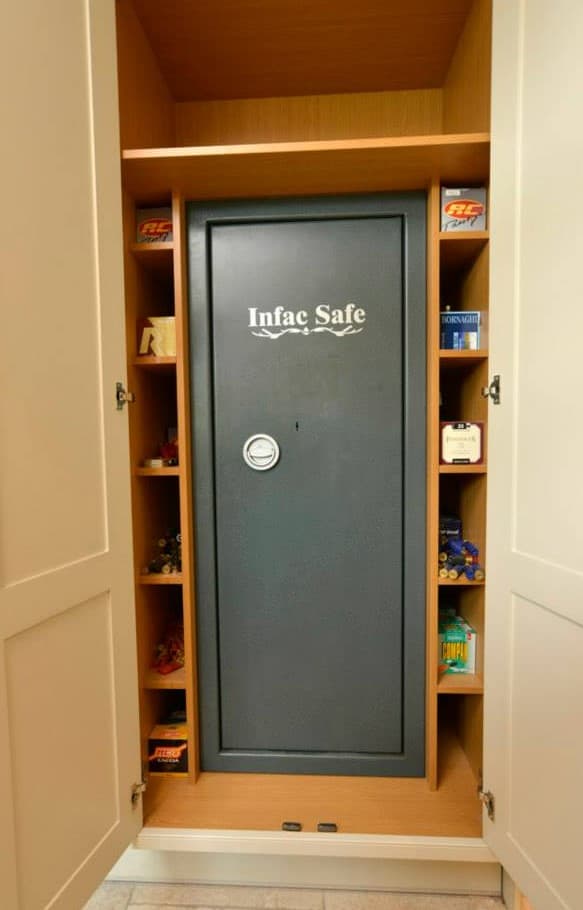
A gun safe is usually a better option than storing your guns in a closet or in a desk drawer, as these areas are easier for thieves to break into and are less protected from fire. You want your gun safe to be in a secure place.
Putting a gun safe in the garage isn’t the only solution, but it can be one of many. Some people believe that it is a good idea because it keeps guns out of reach of children and other unauthorized people.
Normally, I would advise against putting a gun safe in your garage. But if you don’t have any other option, you can amp up the security by building a closet around it or bolting the gun safe to the floor.
The basement is undoubtedly the best place to put your gun safe. However, you can also place your safe inside a bedroom closet.
However, many homeowners are concerned about the safety and have found that their garage can be an unsafe place to store their guns. So, what should you do? Is it okay to put a gun safe in the garage?
The answer to this question is not as simple as it may seem. Some people are of the opinion that a gun safe is never safe enough and should be kept in the house. Others believe it is fine to keep one in the garage, so long as the garage door has a lock on it.
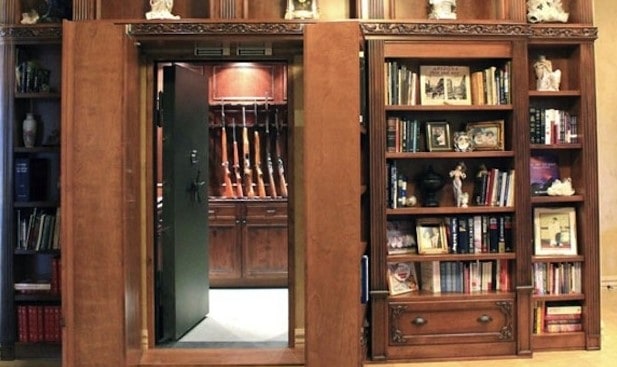
Can You Put A Gun Safe In The Garage?
A gun safe whether it is a small pistol box or a fireproof long gun safe, it is an important investment for any firearm owner. It will keep your guns away from kids and burglars. But does that mean you can put it in the garage?
I don’t recommend putting gun safes in the garage, but if there are no other options, it’s a good idea to bolt them to the garage floor and build a closet around it. You can put the gun safe inside the closet in your bedroom, but the basement is the best place.
Why Install a Gun Safe in the Garage?
Gun safes can be installed in the garage for a number of reasons. You’ll be able to use it there because that’s where the available space is. You may not have a place big enough for your safe based on the layout of your home and the size of your gun safe.
In light of the current situation, temporarily installing your bedroom gun safe in your garage might be a good idea. We strongly encourage you to do so. You still get protection while minimizing risk.
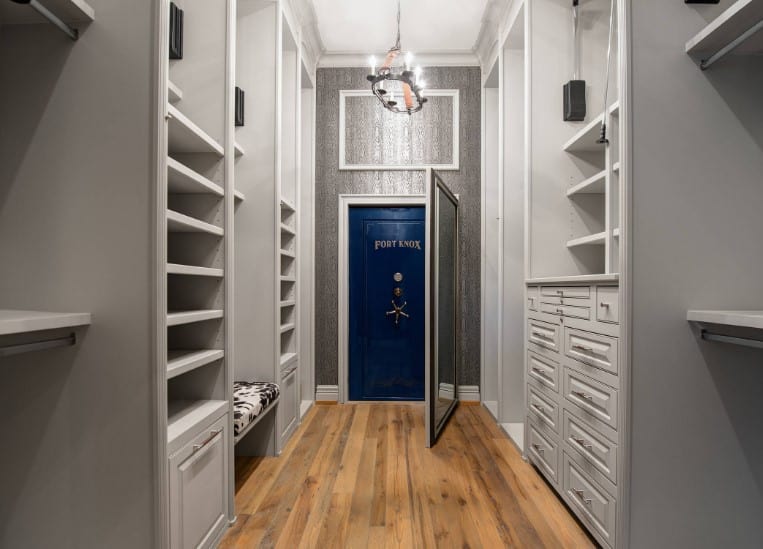
Why You Shouldn’t Install A Gun Safe In The Garage
You could place gun safes in the garage, but you would have to deal with problems such as extreme temperatures, humidity, fire risks, and easy accessibility.
It would be best to consider those risks when installing a gun safe in your garage. In general, gun safes should not be kept in a garage due to a few reasons. Let’s take a look.
Provides Easy Access To Strangers
In many houses, the garage is located in the front part of the house where people can see it from the street.
If there are any interesting items inside, they may be noticed by others passing by.
A gun safe should not be installed in the garage because it is not concealed enough and could easily be noticed from the street.
A better alternative is to install it in your basement or somewhere else on your property where it can’t be seen from the street.
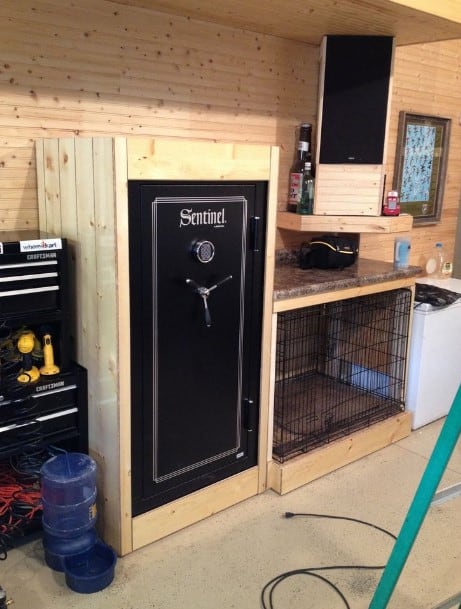
Fire Risk
Many people believe that installing a gun safe in the garage is a good move. The reasoning is that it will be protected from burglars and other criminals.
However, this could be a bad idea because the garage contains flammable items such as gas, oil, paint thinner, etc. If your garage catches on fire, your gun safe will be the first thing to go.
Temperature Fluctuation
Garages are likely to be very humid. Because garage doors are not watertight and are not completely insulated, they don’t receive as much sunlight as the house.
During the rainy season, the cold temperature of the rain finds its way into your garage and increases the humidity level inside. To tackle that problem, you should invest in a dehumidifier for garage.
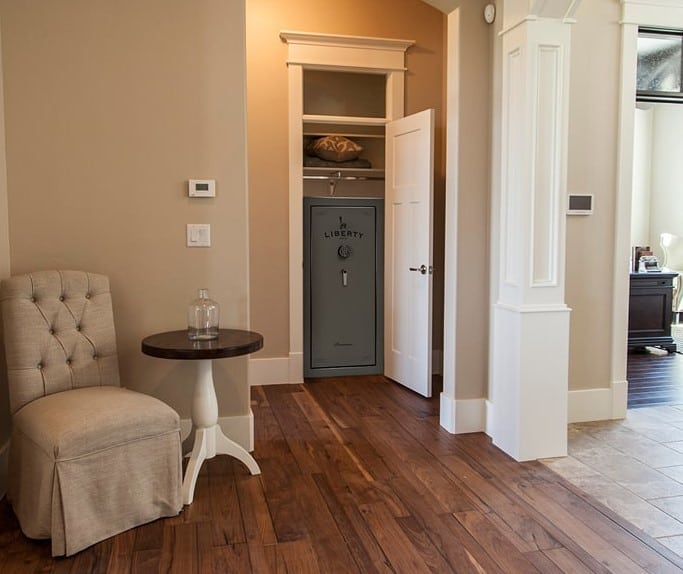
How To Safely Install A Gun Safe In Your Garage?
Although it’s still debatable whether gun safes in garages are safe, it’s a popular option, especially for those with limited space.
Before deciding whether you should install a gun safe in your garage, there are a number of factors you should consider. We recommend that you read our guide and make an informed decision before starting the installation process.
1. Measure The Space
The first thing you should do is measure the space where you want to put the gun safe and measure the size of your doorway and garage door.
You want to make sure that there is enough room for the door to open all the way without hitting anything. If not, then you will need to move or modify something before installing a new long gun safe.
2. Keep The Path Clear
It is common for garage installations to have flat entry points without stairs. Yet, homeowners often have a lot of stuff in their garages.
The gun safe installation crew needs a clear path between your garage door and your safe’s final resting place so they can safely and correctly install your safe.
3. Adjust The Safe’s Level To Create A Pocket For Airflow
Getting your safe up off the ground and creating an airflow pocket underneath it is beneficial for two reasons:
A leveled safe guarantees the proper swing of the door when you open it. You may experience unexpected door swings while accessing the contents of your safe if your safe is not level. In the case of a 500-pound door suddenly closing on you, it can be both annoying and dangerous.
Rust is less likely to form. Insufficient airflow under a safe can lead to moisture accumulation. You may not know this, but rust forms because of moisture. When a metal is exposed to air and moisture, it corrodes and rusts.
This is bad news for metal surfaces everywhere, but if you have a safe with insufficient airflow under it, water can accumulate in the space between the safe and the floor.
You must first remove your safe from its delivery pallet and place it on a barrier before it can be leveled. Shims made of wood and composite can be used to make sure your safe door doesn’t get moved around while you are putting it in place.
It is not recommended to use rubber mats or pieces of plywood since they trap moisture and do not allow for proper air circulation.
4. Make Sure The Dehumidifier And Desiccant Are Working
Most people ask, “Can I install a gun safe in my garage?” because they are concerned about humidity. However, you shouldn’t overlook this issue. However, you can do certain things in order to protect the gun safe and its contents from rust and mildew.
Dehumidifiers and desiccant cans are therefore always recommended in conjunction. The moisture won’t just be reduced, but your safe will also be protected in case one of your dehumidifiers breaks down.
Despite the fact that heating elements and desiccants serve different purposes, they work together to accomplish a common goal. Assuring that your firearms and valuables will be kept in an environment that is healthy.
The Desiccant Can
The crystals inside the desiccant can absorb moisture. It is often recommended that you use rechargeable desiccant dehumidifiers, which can be used repeatedly. Additionally, you can purchase a one-time use desiccant dehumidifier.
They don’t require electricity, which is yet another advantage of desiccant dehumidifiers. As a result, they keep working even if the power goes out, and are especially vital if your safe doesn’t have a power outlet.
The Golden Rod
Our recommended dehumidifier is an energy-efficient heating element called a golden rod. Warm air is circulated throughout your safe to prevent rust, mold, and mildew from accumulating on your firearms and documents.
To take advantage of how hot air naturally rises, you should place your rod at the bottom of the safe. Golden rods, however, need electricity to function.
5. Mounting Your Safe to Your Garage Floor
We recommend bolting your safe to the garage floor to make it more difficult for someone to pry it open. Attaching the floor between the concrete walls and the safe is one of the most common techniques.
Expansion anchors and ramset anchors are the most common. Despite the ease of installation, neither of these methods is very secure, so if you ever want to move your safe, you can face difficulties and even damage it.
The concrete can be pre-drilled with a Roto-Hammer, then Simpson Titan anchors can be securely driven into the concrete with an impact driver through the bottom of the safe. Anchor bolts measuring 3/8″ x 3″ are usually placed at each corner of the safe for best results.
Precaution:
Be careful when overtightening the anchors as it may damage the safe and impair its function. The bolts are threaded into the concrete using this technique.
With this technique, apart from being stronger, it is possible to unbolt the safe and fill the hole with a concrete patch as if the safe had never been there.
I prefer this method to other cheaper methods because my years of experience lead me to it. Moreover, it provides the ability to pass down the investment from generation to generation.
5. Minimize Visibility
Covering up your gun safe is probably one of the easiest and simplest ways to mitigate theft risks. If you want to hide your gun safe, you can use tarps, boxes, or even other objects you find in your garage. Alternatively, you can use a horizontal gun safes like the ones that goes under the bed.
What Is The Proper Temperature For Storing Guns?
A gun owner should make sure their safe has a fire rating as well when storing their guns. For a safe to be effective, it should be able to withstand high temperatures and fire for at least 30 minutes. Usually, gun safes have temperature ratings between 0 and 70 degrees Fahrenheit.
Would It Be Possible To Move Your Safe Later?
Yes, most definitely. If you want to move your safe after it has been installed, you can most definitely can. For example, you can bolt the garage to your concrete floor now and then unbolt it and move it to wherever you want it.
Are Gun Safes Corrosive?
Indeed. The gun safe industry markets all these anti-corrosion products to mask the fact that corrosion really is a threat. If your gun safe’s interior is made from steel, for instance, it will begin to corrode, no matter what type of material it is made from.
For the purpose of preventing rust inside gun safes, manufacturers have added coatings and liners, which are now available on the market. Additionally, there are specific spots where you can place a gun safe dehumidifier.
Final Words
You need to deal with many problems like temperature, fire risk, and easy access by strangers when installing a gun safe in the garage. You can choose the best treatment to keep your gun safe and in good shape by understanding the problems.
Basically, I recommend against placing gun safes in garages because they pose more problems than they’re worth. But if there are no other options, then making sure that everything is in order is necessary.
A gun safe in your garage should be chosen carefully, your humidity levels should be controlled, and a small platform should be added. You must maintain your guns properly, and you should also keep your guns away from hazards that could prove fatal.
Also, if possible, consider storing it inside or in another location that is easier to monitor. As for me, I like my gun safes close by. That is why I prefer smaller, biometric gun safes. Those can be accessed quickly while still offering adequate protection.

